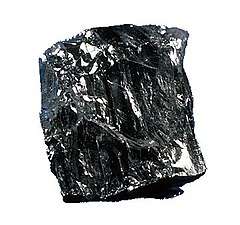Coal-seam fire
A coal-seam fire is a natural burning of an outcrop or underground coal seam. Most coal-seam fires exhibit smoldering combustion,[1] particularly underground coal-seam fires, because of limited atmospheric oxygen availability. Coal-seam fire instances on Earth date back several million years.[2][3] Due to fine thermal insulation and the avoidance of rain/snow extinguishment by the crust, underground coal-seam fires are the most persistent fires on Earth and can burn for thousands of years, like Burning Mountain in Australia.[4] Coal-seam fires can be ignited by self-heating of low-temperature oxidation, lightning, wildfires and even arson. Coal-seam fires have been slowly shaping the lithosphere and changing atmosphere, but this pace has become fast and extensive at modern times, triggered by enormous mining activities.[5]
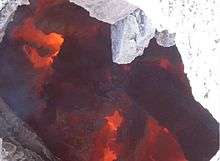
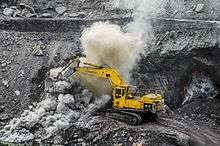
Coal fires are a serious health and safety hazard, affecting the environment by releasing toxic fumes, reigniting grass, brush, or forest fires, and causing subsidence of surface infrastructure such as roads, pipelines, electric lines, bridge supports, buildings, and homes. Whether started by humans or by natural causes, coal seam fires continue to burn for decades or even centuries until either the fuel source is exhausted, a permanent groundwater table is encountered, the depth of the burn becomes greater than the ground's capacity to subside and vent, or humans intervene. Because they burn underground, coal seam fires are extremely difficult and costly to extinguish, and are unlikely to be suppressed by rainfall.[6] There are strong similarities between coal fires and peat fires.
Across the world, thousands of underground coal fires are burning at any given moment. The problem is most acute in industrializing, coal-rich nations such as China.[7] Global coal fire emissions are estimated to cause 40 tons of mercury to enter the atmosphere annually, and to represent three percent of the world's annual CO2 emissions.[8]
Origins
Coal seam fires can be divided into near-surface fires, in which seams extend to the surface and the oxygen required for their ignition comes from the atmosphere, and fires in deep underground mines, where the oxygen comes from ventilation.
Mine fires may begin as a result of an industrial accident, generally involving a gas explosion. Historically, some mine fires were started when bootleg mining was stopped by authorities, usually by blowing the mine up. Many recent mine fires have started from people burning trash in a landfill that was in proximity to abandoned coal mines, including the much-publicized Centralia, Pennsylvania, fire, which has been burning since 1962. Of the hundreds of mine fires in the United States burning today, most are found in the state of Pennsylvania.
Some fires along coal seams are natural occurrences. Some coals may self-ignite at temperatures as low as 80 °C (104 °F) for brown coal in the right conditions of moisture and grain size.[9] The fire usually begins a few decimeters inside the coal at a depth in which the permeability of the coal allows the inflow of air but in which the ventilation does not remove the heat which is generated. Self-ignition was a recognised problem in steamship times and is claimed to have contributed to the sinking of the Titanic. One well known source of fires is mining breaking into a high pressure cavity of methane gas which on release can generate a spark of static electricity to ignite the gas and start a coal explosion and fire. The same gas static is well known in ships and care has to be taken to ensure no such static sparking can occur.
Two basic factors determine whether spontaneous combustion occurs or not, the ambient temperature and the grain size:
- The higher the ambient temperature, the more quickly the oxidation reactions proceed.
- The grain size and structure determine its surface area. Kinetics will be limited by availability of reactant, which in this case is carbon exposed to oxygen.
Wildfires (lightning-caused or others) can ignite the coal closer to the surface or entrance, and the smouldering fire can spread through the seam, creating subsidence that may open further seams to oxygen and spawn future wildfires when the fire breaks to the surface. Prehistoric clinker outcrops in the American West are the result of prehistoric coal fires that left a residue that resists erosion better than the matrix, leaving buttes and mesa. It is estimated that Australia's Burning Mountain, the oldest known coal fire, has burned for 6,000 years.[10]
Globally, thousands of inextinguishable mine fires are burning, especially in China where poverty, lack of government regulations and runaway development combine to create an environmental disaster. Modern strip mining exposes smoldering coal seams to the air, revitalizing the flames.
Rural Chinese in coal-bearing regions often dig coal for household use, abandoning the pits when they become unworkably deep, leaving highly combustible coal dust exposed to the air. Using satellite imagery to map China's coal fires resulted in the discovery of many previously unknown fires. The oldest coal fire in China is in Baijigou (白芨沟, in Dawukou District of Shizuishan City, Ningxia) and is said to have been burning since the Qing Dynasty (before 1912).[11]
Detection
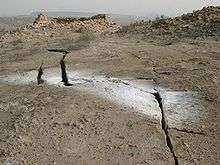
Before attempting to extinguish a near-surface coal seam fire, its location and underground extent should be determined as precisely as possible. Besides studying the geographic, geologic and infrastructural context, information can be gained from direct measurements. These include:
- Temperature measurements of the land surface, in fissures and boreholes, for example using pyrometers
- Gas measurements to characterize the fire ventilation system (amount and velocity) and the gas composition, so that the combustion reactions can be described
- Geophysical measurements on the ground and from airplanes and helicopters to establish the extent of conductivity or other underground parameters. For example, conductivity measurements map humidity changes near the fire; measuring the magnetism can determine changes in the magnetic characteristics of the adjacent rock caused by heat
- Remote sensing from aircraft and satellites. High resolution optical mapping, thermal imaging and hyperspectral data play a role. Underground coal fires of several hundred to over a thousand degrees Celsius may raise the surface temperature by only a few degrees. This order of magnitude is similar to the temperature difference between the sunlit and shadowed slopes of a slag heap or sand dune. Infrared detecting equipment is able to track the fire's location as the fire heats the ground on all sides of it.[12] However, remote sensing techniques are unable to distinguish individual fires burning near one another and often lead to undercounting of actual fires.[13] They may also have some difficulties distinguishing coal seam fires from forest fires. Combining in-situ data with remote sensing data does allow for monitoring of coal fire intensity over longer periods of time using time-series analyses.[14]
Underground coal mines can be equipped with permanently installed sensor systems. These relay pressure, temperature, airflow and gas composition measurements to the safety monitoring personnel, giving them early warning of any problems.
Environmental impact
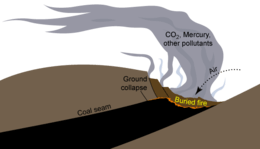
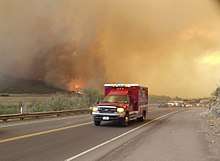
Besides destruction of the affected areas, coal fires often emit toxic gases, including carbon monoxide and sulfur dioxide. China's coal fires, which consume an estimated 20 – 200 million tons of coal a year, make up as much as 1 percent of the global carbon dioxide emissions from fossil fuels.[10]
One of the most visible changes will be the effect of subsidence upon the landscape. Another local environmental effect can include the presence of plants or animals that are aided by the coal fire. The prevalence of otherwise non-native plants can depend upon the fire's duration and the size of the affected area. For example, near a coal fire in Germany, many Mediterranean insects and spiders were identified in a region with cold winters, and it is believed that elevated ground temperatures above the fires permitted their survival.[15]
Extinguishing coal fires
In order to thrive, a fire requires fuel, oxygen, and heat. As underground fires are very difficult to reach directly, firefighting involves finding an appropriate methodology which addresses the interaction of fuel and oxygen for the specific fire in question. A fire can be isolated from its fuel source, for example through firebreaks or fireproof barriers. Many fires, particularly those on steep slopes, can be completely excavated. In the case of near-surface coal seam fires, the influx of oxygen in the air can be interrupted by covering the area or installing gas-tight barriers. Another possibility is to hinder the outflow of combustion gases so that the fire is quenched by its own exhaust fumes. Energy can be removed by cooling, usually by injecting large amounts of water. However, if any remaining dry coal absorbs water, the resulting heat of absorption can lead to re-ignition of a once-quenched fire as the area dries. Accordingly, more energy must be removed than the fire generates. In practice these methods are combined, and each case depends on the resources available. This is especially true for water, for example in arid regions, and for covering material, such as loess or clay, to prevent contact with the atmosphere.
Extinguishing underground coal fires, which sometimes exceed temperatures of 540 °C (1,000 °F), is both highly dangerous and very expensive.[10]
Near-surface coal seam fires are routinely extinguished in China following a standard method basically consisting of the following phases:
- Smoothing the surface above the fire with heavy equipment to make it fit for traffic.
- Drilling holes in the fire zone about 20 m apart down to the source of the fire, following a regular grid.
- Injecting water or mud in the boreholes long term, usually 1 to 2 years.
- Covering the entire area with an impermeable layer about 1 m thick, e.g., of loess.
- Planting vegetation to the extent the climate allows.
Efforts are underway to refine this method, for example with additives to the quenching water or with alternative extinguishing agents.
Underground coal seam fires are customarily quenched by inertization through mine rescue personnel. Toward this end the affected area is isolated by dam constructions in the galleries. Then an inert gas, usually nitrogen, is introduced for a period of time, usually making use of available pipelines.
In 2004, the Chinese government claimed success in extinguishing a mine fire at a colliery near Urumqi in China's Xinjiang province that had been burning since 1874. However, a March 2008 Time magazine article quotes researcher Steven Q. Andrews as saying, "I decided to go to see how it was extinguished, and flames were visible and the entire thing was still burning.... They said it was put out, and who is to say otherwise?"[16]
A jet engine unit, known as Gorniczy Agregat Gasniczy (GAG), was developed in Poland and successfully used for fighting coal fires and displacing firedamp in mines.
Current research and new developments in extinguishing fires
Time magazine reported in July 2010 that less expensive alternatives for extinguishing coal seam fires were beginning to reach the market, including special heat-resistant grouts and a fire-smothering nitrogen foam, with other innovative solutions on the way.[8]
Microbes and drug discovery
Scientists have recently begun to explore thermal vents for unique soil bacteria capable of producing new pharmaceutical leads. Soil microbes have long been a source for effective drugs[17] and new research, such as that conducted at the Center for Pharmaceutical Research and Innovation, suggests these extreme environments to be an untapped source for new discovery.[18][19][20][21][22][23]
List of mine fires
Some of the more notable mine fires around the world are listed below.
Australia
- Burning Mountain - a naturally occurring, slow combusting underground coal seam
- Morwell, Victoria – the Great Morwell open cut mine caught fire in March 1902 and burned for over a month. It was extinguished by breaching the nearby Morwell River with explosives to flood the mine. The fire was found to have been caused by sabotage from incendiary devices.[24][25]
- Hazelwood Power Station – a 2 km coal face in the Hazelwood open cut mine was set alight by a bushfire in October 2006[26] and again in February 2014.[27] Thousands of residents were affected by the fire at the Hazelwood coalmine in 2014 which burned for 45 days sending smoke across the community of Morwell in Victoria.[28] Government advised the vulnerable groups of people in South Morwell to relocate temporarily due to the danger of PM2.5 particulate matter. In May 2020 the Hazelwood Power Corporation was fined $1.56 million fine for occupational health and safety breaches associated with the fire.[29]
Canada
- Elkford, British Columbia[30]
- Merritt, British Columbia
- Carmacks, Yukon
- Smoking Hills, Northwest Territories
China
In China, the world's largest coal producer with an annual output around 2.5 billion tons, coal fires are a serious problem. It has been estimated that some 10–200 million tons of coal uselessly burn annually, and that the same amount again is made inaccessible to mining.[11] Coal fires extend over a belt across the entire north China, whereby over one hundred major fire areas are listed, each of which contains many individual fire zones. They are concentrated in the provinces of Xinjiang, Inner Mongolia and Ningxia. Beside losses from burned and inaccessible coal, these fires contribute to air pollution and considerably increased levels of greenhouse gas emissions and have thereby become a problem which has gained international attention.
Germany
In Planitz, now a part of the city of Zwickau, a coal seam that had been burning since 1476 could only be quenched in 1860.[31][32] In Dudweiler (Saarland) a coal seam fire ignited around 1668 and is still burning today.[33] This so-called Burning Mountain ("Brennender Berg") soon became a tourist attraction and was even visited by Johann Wolfgang von Goethe.[34] Also well-known is the so-called Stinksteinwand (stinking stone wall) in Schwalbenthal on the eastern slope of the Hoher Meißner, where several seams caught fire centuries ago after lignite coal mining ceased; combustion gas continues to reach the surface today.[35]
India
In India, as of 2010, 68 fires were burning beneath a 58-square-mile (150 km2) region of the Jharia coalfield in Dhanbad, Jharkhand. Mine fires started in this region in 1916 and are rapidly destroying the only source of prime coking coal in the country.[36]
Indonesia
Coal and peat fires in Indonesia are often ignited by forest fires near outcrop deposits at the surface. It is difficult to determine when a forest fire is started by a coal seam fire, or vice versa, in the absence of eyewitnesses.[6] The most common cause of forest fires and haze in Indonesia is intentional burning of forest to clear land for plantation crops of pulp wood, rubber and palm oil.
No accurate count of coal seam fires has been completed in Indonesia. Only a minuscule fraction of the country has been surveyed for coal fires.[6] The best data available come from a study based on systematic, on-the-ground observation. In 1998, a total of 125 coal fires were located and mapped within a 2-kilometer strip either side of a 100-kilometer stretch of road north of Balikpapan to Samarinda in East Kalimantan, using hand-held Global Positioning System (GPS) equipment. Extrapolating this data to areas on Borneo and Sumatra underlain by known coal deposits, it was estimated that more than 250,000 coal seam fires may have been burning in Indonesia in 1998.[13]
Land clearing practices which use fire, often starting forest fires, may be the cause of coal seam fires in Indonesia. In 1982–83 one of the largest forest fires in this century raged for several months through an estimated 5 million hectares of Borneo's tropical rainforests. Goldammer and Seibert however concluded that there are indications that coal seam fires already occurred between 13,200 and 15,000 BP.[37]
A fire season usually occurs every 3–5 years, when the climate in parts of Indonesia becomes exceptionally dry from June to November due to the El Nino Southern Oscillation off the west coast of South America. Since 1982, fire has been a recurring feature on the Islands of Borneo and Sumatra, burning large areas in 1987, 1991, 1994, 1997–98, 2001 and 2004.[13]
In October 2004 smoke from land clearing again covered substantial portions of Borneo and Sumatra, disrupting air travel,[38] increasing hospital admissions,[39] and extending to portions of Brunei, Singapore and Malaysia.[40] Coal outcrops are so common in Indonesia it is virtually certain these fires ignited new coal seam fires.
New Zealand
- Burnett's Face, West Coast
- Strongman Mine, West Coast
- Wangaloa, Otago[41]
- Pike River Mine, West Coast
- Millerton area, Stockton Mine, West Coast, South Island, New Zealand
Norway
In 1944, Longyearbyen Mine #2 on Svalbard was set alight by sailors from the Tirpitz on its final sortie outside of Norwegian coastal waters. The mine continued to burn for 20 years, while some of the areas were subsequently mined from the reconstructed Mine #2b.
South Africa
- Transvaal and Delagoa Bay Collieries near Emalahleni (formerly known as Witbank), Mpumalanga has been burning since the mine was abandoned in 1953.[42]
United States
Many coalfields in the US are subject to spontaneous ignition. The federal Office of Surface Mining (OSM) maintains a database (AMLIS), which in 1999 listed 150 fire zones. In mid-2010, according to OSM, more than 100 fires were burning beneath nine states, most of them in Colorado, Kentucky, Pennsylvania, Utah and West Virginia. But geologists say many fires go unreported, so that the actual number of them is nearer to 200, across 21 states.[8]
In Pennsylvania, 45 fire zones are known, the most famous being the Centralia mine fire in the Centralia mine in the hard coal region of Columbia County, which has been burning since 1962.[8] Burning Mine, near Summit Hill, caught fire in 1859.[43]
In Colorado, coal fires have arisen as a consequence of fluctuations in the groundwater level, which can increase the temperature of the coal up to 300 °C, enough to cause it to spontaneously ignite.
The Powder River Basin in Wyoming and Montana contains some 800 billion tons of brown coal, and the Lewis and Clark Expedition (1804 to 1806) reported fires there. Fires have been a natural occurrence in this area for about three million years and have shaped the landscape. For example, an area about 4,000 square kilometers in size is covered with coal clinker, some of it in Theodore Roosevelt National Park, where there is a spectacular view of fiery red coal clinker from Scoria Point.[44]
- Laurel Run, Pennsylvania[45]
- New Castle, Colorado
- Glenwood Springs, Colorado
- Lotts Creek, Kentucky
- Ruth Mullins, Kentucky
- Truman Shephard, Kentucky
- New Straitsville, Ohio
- San Toy, Ohio
- Sego, Utah
- Vanderbilt, Pennsylvania
- Centralia, Pennsylvania
- Carbondale, Pennsylvania
In Popular Culture
The 1991 film Nothing but Trouble, directed and co-written by Dan Aykroyd, features a town, Valkenvania, that has an underground coal fire that has been burning for decades. The mayor/leader of the town references the constantly-burning coalmine fire as the source of his hatred of financiers.
See also
- The Darvaza gas crater, a burning natural gas deposit in Turkmenistan
- Underground coal gasification
- Oil well fire
References
- Rein, G (2013). Smouldering Fires and Natural Fuels. In CM Belcher et al. (Eds) Fire Phenomena and the Earth System: An Interdisciplinary Guide to Fire Science. Wiley and Sons. pp. 15–34.
- Heffern, EL, Coates, DA (2004). "Geologic history of natural coal-bed fires, Powder River basin, USA". International Journal of Coal Geology. 59 (1–2): 25–47. doi:10.1016/j.coal.2003.07.002.
- Zhang, X, Kroonenberg, SB, De Boer, CB (2004). "Dating of coal fires in Xinjiang, north‐west China". Terra Nova. 16 (2): 68–74. doi:10.1111/j.1365-3121.2004.00532.x.
- Ellyett, CD, Fleming, AW (1974). "Thermal infrared imagery of the Burning Mountain coal fire". Remote Sensing of Environment. 3: 79–86. doi:10.1016/0034-4257(74)90040-6.
- Song, Z, Kuenzer, C (2014). "Coal fires in China over the last decade: A comprehensive review". International Journal of Coal Geology. 133: 72–99. doi:10.1016/j.coal.2014.09.004.
- Whitehouse, Alfred; Mulyana, Asep A. S. (2004). "Coal Fires in Indonesia". International Journal of Coal Geology. Amsterdam: Elsevier. 2012 (1–2): 91–97 [p. 95]. doi:10.1016/j.coal.2003.08.010. ISSN 0166-5162.
- Song, Z, Kuenzer, C (2014). "Coal fires in China over the last decade: A comprehensive review". International Journal of Coal Geology. 133: 72–99. doi:10.1016/j.coal.2014.09.004.
- Dan Cray (July 23, 2010). "Deep Underground, Miles of Hidden Wildfires Rage". Time Magazine.
- Kuenzer, C. and G. B. Stracher (2012). "Geomorphology of coal seam fires." Geomorphology 138(1): 209-222.
- Krajick, Kevin (2005-05-01). "Fire in the Hole". Smithsonian Magazine. pp. 54ff. Retrieved 2007-01-16.
- Rennie, David (1 February 2002). "How China's scramble for 'black gold' is causing a green disaster". The Daily Telegraph. London. Retrieved 30 April 2010.
- J. Zhang; W. Wagner; A. Prakash; H. Mehl; S. Voigt (2004). "Detecting coal fires using remote sensing techniques". International Journal of Remote Sensing. 25 (16): 3193–3220. Bibcode:2004IJRS...25.3193Z. doi:10.1080/01431160310001620812.
- Hamilton, Michael S., Richard O. Miller, and Alfred E. Whitehouse. 2000a. "The Continuing Fire Threat in Southeast Asia." Environmental Science & Technology 34(February): 82A-85A).
- S. Song; C. Kuenzer; Z. Zhang; Y. Jia; Y. Sun; J. Zhang (2015). "Detecting coal fires using remote sensing techniques". International Journal of Coal Geology. 141: 91–102. doi:10.1016/j.coal.2015.03.008.
- nabu-aachen-land.de: Bergehalden im Aachener Revier
- Is Beijing Manipulating Air Pollution Statistics?, TIME, 14 March 2008 (retrieved 17 March 2008)
- Dias D.A.; Urban S.; Roessner U. (2012). "A Historical Overview of Natural Products in Drug Discovery". Metabolites. 2012 (2): 303–336. doi:10.3390/metabo2020303. PMC 3901206. PMID 24957513.
- Shaaban, KA; Wang, X; Elshahawi, SI; Ponomareva, LV; Sunkara, M; Copley, GC; Hower, JC; Morris, AJ; Kharel, MK; Thorson, JS (27 September 2013). "Herbimycins D-F, ansamycin analogues from Streptomyces sp. RM-7-15". Journal of Natural Products. 76 (9): 1619–26. doi:10.1021/np400308w. PMC 3852429. PMID 23947794.
- Wang, X; Shaaban, KA; Elshahawi, SI; Ponomareva, LV; Sunkara, M; Zhang, Y; Copley, GC; Hower, JC; Morris, AJ; Kharel, MK; Thorson, JS (23 August 2013). "Frenolicins C-G, pyranonaphthoquinones from Streptomyces sp. RM-4-15". Journal of Natural Products. 76 (8): 1441–7. doi:10.1021/np400231r. PMC 3862173. PMID 23944931.
- Wang X.; Elshahawi S.I.; Shaaban K.A.; Fang L.; Ponomareva L.V.; Zhang Y.; Copley G.C.; Hower J.C.; Zhan C.-G.; Kharel M.K.; Thorson J.S. (2014). "Ruthmycin, a new tetracyclic polyketide from Streptomyces sp. RM-4-15". Org. Lett. 16 (2): 456–459. doi:10.1021/ol4033418. PMC 3964319. PMID 24341358.
- Wang X.; Shaaban K.A.; Elshahawi S.I.; Ponomareva L.V.; Sunkara M.; Copley G.C.; Hower J.C.; Morris A.J.; Kharel M.K.; Thorson J.S. (2014). "Mullinamides A and B, new cyclopeptides produced by the Ruth Mullins coal mine fire isolate Streptomyces sp. RM-27-46". J. Antibiot. 67 (8): 571–575. doi:10.1038/ja.2014.37. PMC 4146655. PMID 24713874.
- Shaaban, KA; Singh, S; Elshahawi, SI; Wang, X; Ponomareva, LV; Sunkara, M; Copley, GC; Hower, JC; Morris, AJ; Kharel, MK; Thorson, JS (March 2014). "Venturicidin C, a new 20-membered macrolide produced by Streptomyces sp. TS-2-2". The Journal of Antibiotics. 67 (3): 223–30. doi:10.1038/ja.2013.113. PMC 3969387. PMID 24252813.
- Wang, X; Reynolds, AR; Elshahawi, SI; Shaaban, KA; Ponomareva, LV; Saunders, MA; Elgumati, IS; Zhang, Y; Copley, GC; Hower, JC; Sunkara, M; Morris, AJ; Kharel, MK; Van Lanen, SG; Prendergast, MA; Thorson, JS (5 June 2015). "Terfestatins B and C, New p-Terphenyl Glycosides Produced by Streptomyces sp. RM-5-8". Organic Letters. 17 (11): 2796–9. doi:10.1021/acs.orglett.5b01203. PMC 4472964. PMID 25961722.
- "Coal mine fired by incendiary". The Advertiser. 1902-04-01.
- "A coal mine on fire". The Argus. 1902-04-02.
- "Massive coal mine blaze still burning". The Age. 2006-10-13.
- "Report of the Hazelwood Mine Fire Inquiry 2014".
- "Morwell coalmine fire finally extinguished after 45 days". Guardian. 25 March 2014. Retrieved 22 April 2014.
- https://www.abc.net.au/news/2020-05-19/hazelwood-power-station-latrobe-valley-2014-mine-fire-fine/12261858
- Takuya Shimoda. "Wireless High Speed Internet Provider- Tough Country Communications – Home". Archived from the original on 21 July 2010. Retrieved 16 August 2015.
- Peschke, Norbert (1998). Planitz im Wandel der Zeiten [Planitz Through the Ages] (in German). Sutton Verlag GmbH. p. 18. ISBN 978-3-89702-016-0.
- "Der Planitzer Erdbrand" [The coal seam fire of Planitz]. WAS IST WAS (in German). Retrieved 2016-10-03.
- "Das Naturdenkmal Brennender Berg bei Dudweiler" [The natural monument Burning Mountain in Dudweiler]. Mineralienatlas (in German). Retrieved 2016-10-03.
- Fell, Günter. "Goethe" (in German). Retrieved 2016-10-03.
- Gemeinde Meißner. "Der Berg Meißner" (in German). Retrieved 2016-10-03.
An der Stinksteinwand in der Nähe des Gasthauses Schwalbenthal strömen im Übrigen seit 300 Jahren durch die Klüfte des Basaltes die Gase eines schwelenden Kohleflözes aus.
- "Mine fires (India)". Retrieved 15 June 2012.
- Goldammer, J.G.; Seibert, B. (1989): Natural rain forest fires in Eastern Borneo during the Pleistocene and Holocene, Naturwissenschaften, November 1989, Volume 76, Issue 11, p. 518-520
- "Haze disrupts flights in Central Kalimantan." 2004. Jakarta Post 17 October, 1.
- "Haze thick over Kalimantan." 2004. Jakarta Post 19 October, 1.
- "Haze thickens in Sumatra and Kalimantan, affects Malaysia." 2004. Jakarta Post 16 October, 1.
- "Coal Mine Restoration in New Zealand, Geology Department, University of Otago, New Zealand". Otago.ac.nz. September 1, 2004. Archived from the original on October 16, 2008. Retrieved December 19, 2012.
- Limpitlaw; Aken, Lodewijks & Viljoen (2005-07-13). "Sustainable Development in the life of coal mining in South Africa" (PDF). The South African Institute of Mining and Metallurgy. p. 3. Retrieved 16 January 2010.
- "Summit Hill", in The Columbia-Viking Desk Encyclopedia (1953), New York: Viking.
- "North Dakota's Clinker". Retrieved 16 August 2015.
- "Laurel Run". Retrieved 16 August 2015.
Further reading
- Kuenzer, C.; Zhang, J.; Tetzlaff, A.; van Dijk, P.; Voigt, S.; Mehl, H.; Wagner, W. (2007). "Uncontrolled coal fires and their environmental impacts: Investigating two arid mining regions in north-central China". Applied Geography. 27: 42–62. doi:10.1016/j.apgeog.2006.09.007.
- "Satellites track the fires raging beneath India". New Scientist. 2006-07-18. pp. 25ff. Retrieved 2007-01-16.
- Kuenzer, C.; Stracher, G. (2011). "Geomorphology of Coal Seam Fires". Geomorphology. 138 (1): 209–222. Bibcode:2012Geomo.138..209K. doi:10.1016/j.geomorph.2011.09.004.
- Van Dijk, P.; Zhang, J.; Jun, W.; Kuenzer, C.; Wolf, W.H. (2011). "Assessment of the contribution of in-situ combustion of coal to greenhouse gas emission; based on a comparison of Chinese mining information to previous remote sensing estimates". International Journal of Coal Geology. 86: 108–119. doi:10.1016/j.coal.2011.01.009.
- Zhang, J.; Kuenzer, C. (2007). "Thermal surface characteristics of coal fires 1: Results of in-situ measurements". Journal of Applied Geophysics. 63 (3–4): 117–134. Bibcode:2007JAG....63..117Z. doi:10.1016/j.jappgeo.2007.08.002.
- Zhang, J.; Kuenzer, C.; Tetzlaff, A.; Oettl, D.; Zhukov, B.; Wagner, W. (2007). "Thermal characteristics of coal fires 2: Results of measurements on simulated coal fires". Journal of Applied Geophysics. 63 (3–4): 135–147. Bibcode:2007JAG....63..135Z. doi:10.1016/j.jappgeo.2007.08.003.
- Kuenzer, C.; Hecker, C.; Zhang, J.; Wessling, S.; Wagner, W. (2008). "The potential of multi-diurnal MODIS thermal bands data for coal fire detection". International Journal of Remote Sensing. 29 (3): 923–944. Bibcode:2008IJRS...29..923K. doi:10.1080/01431160701352147.
- Kuenzer, C.; Zhang, J.; Li, J.; Voigt, S.; Mehl, H.; Wagner, W. (2007). "Detection of unknown coal fires: synergy of coal fire risk area delineation and improved thermal anomaly extraction". International Journal of Remote Sensing. 28 (20): 4561–4585. Bibcode:2007IJRS...28.4561K. doi:10.1080/01431160701250432.
- Wessling, S.; Kuenzer, C.; Kesselsf, W.; Wuttke, M. (2008). "Numerical modelling to analyze underground coal fire induced thermal surface anomalies". International Journal of Coal Geology. 74: 175–184. doi:10.1016/j.coal.2007.12.005.
- Kuenzer, C.; Zhang, J.; Sun, Y.; Jia, Y.; Dech, S. (2012). "Coal fires revisited: the Wuda coal field in the aftermath of extensive coal fire research and accelerating extinction activities". International Journal of Coal Geology. 102: 75–86. doi:10.1016/j.coal.2012.07.006.
- Vallero, Daniel; Letcher, Trevor (2012). Unraveling Environmental Disasters. Amsterdam: Elsevier Academic Press. ISBN 978-0123970268.
External links
| Wikimedia Commons has media related to Coal seam fires. |
- The Status of Mine Fire Research in the United States, The National Institute for Occupational Safety and Health (NIOSH), Centers for Disease Control and Prevention (2008)
- Encyclopedia of Earth: Coal fires
- Encyclopedia of Earth: Coalfire and remote sensing
- "Coal fires – A natural or man made hazard?" (site about coal mine fires from Anupma Prakash, of the Univ. of Alaska-Fairbanks)
- "Fighting Infernos Underground" "Popular Mechanics, September 1951, pp. 124–130.
- Link to Discover article, 'Earth on Fire'
- Link to Newsweek article, 'Seeking Cures in Kentucky Coal Mines')
- Link to video, UK Looks for Natural Products in Kentucky's Unique Environments
